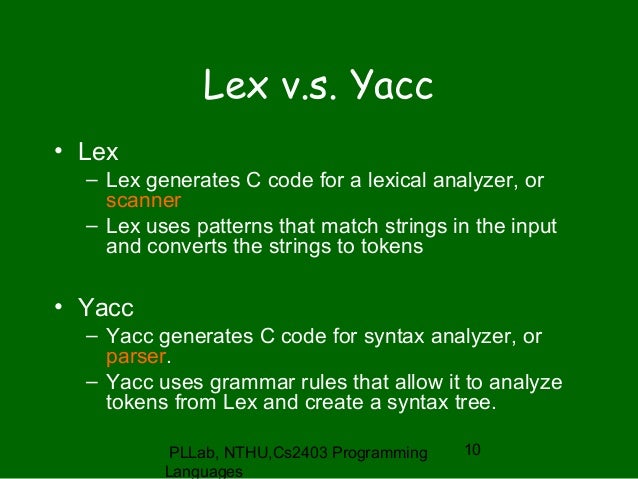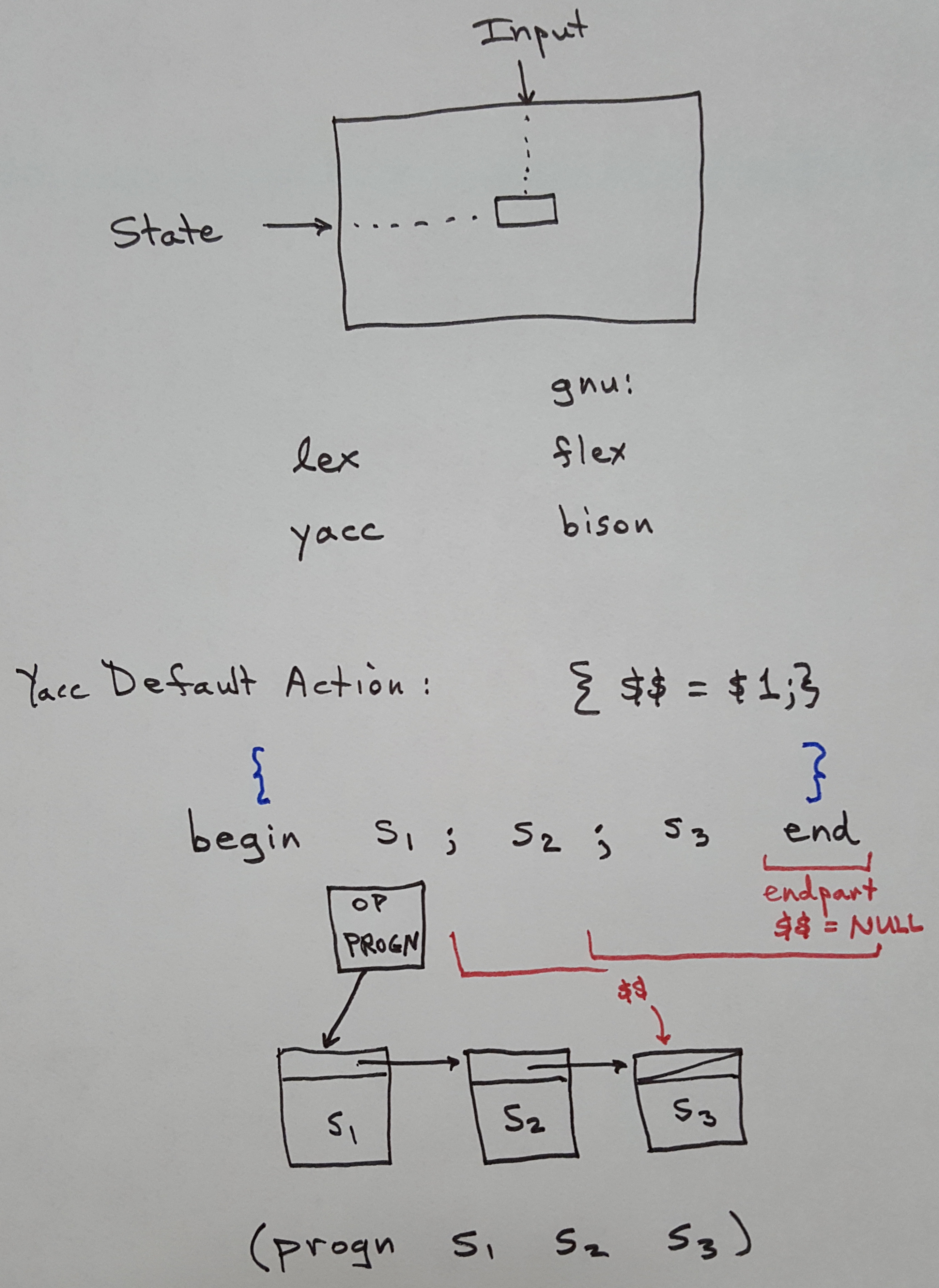Online Lex And Yacc Compiler
- Online Lex And Yacc Compiler Free
- Online Lex And Yacc Compiler Download
- Online Lex And Yacc Compiler C++
- Online Lex And Yacc Compiler Training
- Sly Python
Assignment implement syntax analyzer for sample program

PROBLEM STATEMENT:
- Compiler Project – TD1: Lex & Yacc G. Pasca Lex & YACC Yacc generates a parser in filey.tab.cand an include filey.tab.h(see Fig 2). Lex includes this file (y.tab.h) and uses the definitions for token values found in this file for the returned tokens.
- Online Lex And Yacc Compiler online, free Software Foundations. I used lex and yacc, and in less than a week my compiler was up and running Later, the Free Software Foundations GNU project produced improved versions of lex and yacc - named flex and bison - for use on platforms that did not run a derivative of the Unix operating system.
1. Write a YACC program to check whether the given grammar is valid or not. Consider an input expression and convert it to postfix form.
This video explain the introduction of LEX & YACC, Step by Step procedure to run it.
2. Write a program to Implement YACC for Subset of C (for loop) statement.
OBJECTIVES:
- To understand Second phase of compiler: Syntax Analysis.
To learn and use compiler writing tools.
Understand the importance and usage of YACC automated tool.
THEORY:
Introduction
Parser generator facilitates the construction of the front end of a compiler. YACC is LALR parser generator. It is used to implement hundreds of compilers. YACC is command (utility) of the UNIX system. YACC stands for “Yet Another Compiler Complier”. File in which parser generated is with .y extension. e.g. parser.y, which is containing YACC specification of the translator. After complete specification UNIX command. YACC transforms parser.y into a C program called y.tab.c using LR parser. The program y.tab.c is automatically generated. We can use command with –d option as yacc –d parser.y By using –d option two files will get generated namely y.tab.c and y.tab.h. The header file y.tab.h will store all the token information and so you need not have to create y.tab.h explicitly. The program y.tab.c is a representation of an LALR parser written in C, along with other C routines that the user may have prepared. By compiling y.tab.c with the ly library that contains the LR parsing program using the command. $ gcc y.tab.c
We obtain the desired object program aout that perform the translation specified by the original program. If procedure is needed, they can be compiled or loaded with y.tab.c, just as with any C program.
LEX recognizes regular expressions, whereas YACC recognizes entire grammar. LEX divides the input stream into tokens, while YACC uses these tokens and groups them together logically.LEX and YACC work together to analyze the program syntactically. The YACC can report conflicts or ambiguities (if at all) in the form of error messages.
YACC Specifications:
The Structure of YACC programs consists of three parts:
%{

Definitions Section
%}
%%
Rules Section (Context Free Grammar)
%%

Auxiliary Function
———————————————————————————–
Definition Section:
The definitions and programs section are optional. Definition section handles control information for the YACC-generated parser and generally set up the execution environment in which the parser will operate.
In declaration section, %{ and %} symbol used for C declaration. This section is used for definition of token, union, type, start, associativity and precedence of operator. Token declared in this section can then be used in second and third parts of Yacc specification.
Translation Rule Section:
In the part of the Yacc specification after the first %% pair, we put the translation rules. Each rule consists of a grammar production and the associated semantic action. A set of productions that we have been writing: <left side> <alt 1> | <alt 2> | … <alt n> Would be written in YACC as <left side> : <alt 1> {action 1} | <alt 2> {action 2} … … … … … … … … … … | <alt n> {action n} ; In a Yacc production, unquoted strings of letters and digits not declared to be tokens are taken to be nonterminals. A quoted single character, e.g. ‘c’, is taken to be the terminal symbol c, as well as the integer code for the token represented by that character (i.e., Lex would return the character code for ‘ c’ to the parser, as an integer). Alternative bodies can be separated by a vertical bar, and a semicolon follows each head with its alternatives and their semantic actions. The first head is taken to be the start symbol. A Yacc semantic action is a sequence of C statements. In a semantic action, the symbol $$ refers to the attribute value associated with the nonterminal of the head, while $i refers to the value associated with the ith grammar symbol (terminal or nonterminal) of the body. The semantic action is performed whenever we reduce by the associated production, so normally the semantic action computes a value for $$ in terms of the $i’s. In the Yacc specification, we have written the two E-productions.
E-> E + T/T
and their associated semantic action as:
exp : exp “+” term {$$ = $1 + $3;}
| term ;
In above production exp is $1, „+‟ is $2 and term is $3. The semantic action associated with first production adds values of exp and term and result of addition copying in $$ (exp) left hand side. For above second number production, we have omitted the semantic action since it is just copying the value. In general {$$ = $1;} is the default semantic action.
Supporting C-Routines Section:
The third part of a Yacc specification consists of supporting C-routines. YACC generates a single function called yyparse(). This function requires no parameters and returns either a 0 on success, or 1 on failure. If syntax error over its return 1.The special function yyerror() is called when YACC encounters an invalid syntax. The yyerror() is passed a single string (char) argument. This function just prints user defined message like:
yyerror (char err)
{
printf (“Divide by zero”);
}
When LEX and YACC work together lexical analyzer using yylex () produce pairs consisting of a token and its associated attribute value. If a token such as DIGIT is returned, the token value associated with a token is communicated to the parser through a YACC defined variable yylval. We have to return tokens from LEX to YACC, where its declaration is in YACC. To link this LEX program include a y.tab.h file, which is generated after YACC compiler the program using –d option.
Steps to Execute the program
$ lex filename.l (eg: cal.l)
$ yacc -d filename.y (eg: cal.y)
$gcc lex.yy.c y.tab.c
$./a .out
Lex & Yaccfor Compiler Writing
Some of the most time consuming and tedious parts of writinga compiler involve the lexical scanning and syntax analysis. Luckily there isfreely available software to assist in these functions. While they will not doeverything for you, they will enable faster implementation of the basicfunctions. Lex and Yacc arethe most commonly used packages with Lex managing thetoken recognition and Yacc handling the syntax. Theywork well together, but conceivably can be used individually as well.

Both operate in a similar manner in which instructions fortoken recognition or grammar are written in a special file format. The textfiles are then read by lex and/or yaccto produce c code. This resulting source code is compiled to make the finalapplication. In practice the lexical instruction file has a“.l” suffix and the grammar file has a “.y” suffix. This process is shown inFigure 1.
Figure 1.
The file format for a lex fileconsists of (4) basic sections
- The first is an area for c code that will be place verbatim at the beginning of the generated source code. Typically is will be used for things like #include, #defines, and variable declarations.
- The next section is for definitions of token types to be recognized. These are not mandatory, but in general makes the next section easier to read and shorter.
- The third section set the pattern for each token that is to be recognized, and can also include c code to be called when that token is identified
- The last section is for more c code (generally subroutines) that will be appended to the end of the generated c code. This would typically include a main function if lex is to be used by itself.
- The format is applied as follows (the use and placement of the % symbols are necessary):
%{
//header c code
%}
//definitions
%%
//rules
%%
//subroutines
The format for a yacc file issimilar, but includes a few extras.
- The first area (preceded by a %token) is a list of terminal symbols. You do not need to list single character ASCII symbols, but anything else including multiple ASCII symbols need to be in this list (i.e. “”).
- The next is an area for c code that will be place verbatim at the beginning of the generated source code. Typically is will be used for things like #include, #defines, and variable declarations.
- The next section is for definitions- none of the following examples utilize this area
- The fourth section set the pattern for each token that is to be recognized, and can also include c code to be called when that token is identified
- The last section is for more c code (generally subroutines) that will be appended to the end of the generated c code. This would typically include a main function if lex is to be used by itself.
- The format is applied as follows (the use and placement of the % symbols are necessary):

%tokens RESERVED, WORDS, GO,HERE
Online Lex And Yacc Compiler Free
%{
//header c code
Online Lex And Yacc Compiler Download
%}
//definitions
%%
//rules
%%
Online Lex And Yacc Compiler C++
//subroutines
These formats and general usage will be covered in greaterdetail in the following (4) sections. In general it is best not to modify theresulting c code as it is overwritten each time lexor yacc is run. Most desired functionality can be handledwithin the lexical and grammar files, but there are some things that aredifficult to achieve that may require editing of the c file.
As a side note, the functionality of these programs has beenduplicated by the GNU open source projects Flex and Bison. These can be usedinterchangeably with Lex and Yaccfor everything this document will cover and most other uses as well.
Online Lex And Yacc Compiler Training
Here are some good references for further study:
The Lex & Yaccpage – has great links to references for lex,
Nice tutorial for use of lex &yacc together
Sly Python
http://epaperpress.com/lexandyacc